Not only the quality of construction depends, but also the durability of the house itself.
Therefore, it is very important to protect it from water, which is easily absorbed into concrete and has a detrimental effect on it.
Through capillaries concrete foundation Water can penetrate into the floor of the house, where it promotes the growth of fungi and mold.
Tested by independent and accredited laboratories to demonstrate unrivaled durability and long-term performance. These results are available upon request. The use of specially developed mastic and profiles allows you to close the upper edge of the product and prevent soil particles or surface water from entering behind the membrane.
This air gap assists in the drainage of any pitted moisture passing behind the membrane, directing it to the peripheral flange drain to ensure its evacuation. If you want the product installed by a professional, you can get contact information certified installer in your area by visiting the Contact Us section of our website.
If metal beams or wooden piles are involved in the construction of the foundation, then these materials also need protection from water, since wood is susceptible to rotting and metal is susceptible to corrosion.
Is foundation waterproofing necessary?
For those who forgot to waterproof the foundation during construction, you should know that water that thaws in the spring increases in volume and destroys the foundation of the entire structure. To protect your home from costly repairs in the future, you need to properly waterproof the foundation of your home in advance.
The product warranty covers twenty years of potential premature membrane failure due to manufacturing or material defects. The performance warranty covers the actual installation of the membrane and provides five years of intrusion protection.
Its use as a waterproofing and sealing material is also approved by the International Residential Code and the United States International Building Code. Building codes in several US states also approve these types of applications.
In order to waterproof the foundation of a house yourself, first you need to find out:
- at what depth is the groundwater located?
- how much the earth is saturated with moisture in the spring;
- type of soil;
- type of building and conditions of its operation.
 The type of foundation waterproofing required depends on these factors.
The type of foundation waterproofing required depends on these factors.
With mechanical fasteners like nails, you'll need a hundred units. More detailed installation instructions can be found on the product packaging or website. There is no problem of the latter's compatibility with conventional spray products. Facades make it possible for a home to be watertight, so that it is more resistant to external influences. There are two types of water repellents, for which the use is identical. It is not the same for their health and environmental impacts.
There are two types of facade water repellent materials that have the same waterproofing quality: solvent water repellent and acrylic water repellent. Before applying them to the facade, you must do right choice. The differences between these two water-repellent facade elements are mainly environmentally friendly and hygienic. The effective, water-repellent solvent is also very and relatively hazardous to health. However, acrylic water repellent media is completely healthy and environmentally friendly and can be applied to dry or wet surfaces.
At level groundwater a meter or deeper from the base of the foundation, you can make foundation waterproofing and coating vertical waterproofing.
At a level less than 1 m. From the base of the foundation, horizontal insulation should be laid in two layers, applying mastic between the layers.  As for vertical insulation, then apply coating and paste over roll materials. Also, to make it difficult for water to penetrate through capillaries, it is recommended to treat the basement with penetrating waterproofing.
As for vertical insulation, then apply coating and paste over roll materials. Also, to make it difficult for water to penetrate through capillaries, it is recommended to treat the basement with penetrating waterproofing.
Takes a long time to dry. Whatever waterproofing is used for the selected facade, it is applied in the same way. Use a brush to apply the repellent over the entire surface. Ideal for acrylic waterproofing, it is also a special spray that can cover the façade more evenly for better waterproofing.
After cleaning the slabs, they must be allowed to dry for at least 2-3 days before applying a waterproofing agent. To make sure your tiles are completely dry, do this simple test: Place a sheet of plastic on the tiles the day before waterproofing.
If the construction of a house takes place in a place with a humid climate and the groundwater level is high enough, in addition to the measures described above to protect the foundation, a drainage system should be equipped to drain water into a special one.
Materials for foundation waterproofing
An important question when protecting the foundation of a house is how much does it cost to waterproof the foundation?
The next day after the sheet there should be no traces of moisture or condensation. Again, be sure to stop at the joint so the fittings remain invisible. Parts that require increased protection may need to undergo a second layer of waterproofing. This should be applied 1 - 2 hours after the first coat, at the latest.
Attention: Waterproofing is a harmful and especially volatile product. In addition, always follow the conditions of use indicated on the container. Our terracotta offers many thermal and sound benefits. They are ideal for any type of indoor installation, even underfloor heating. Normal Maintenance This can be done simply with a broom or vacuum cleaner and a woolen cloth. Traces and stains of an internal nature are removed locally using a sponge, and then passed through a woolen cloth.
This depends on several factors: the area of the surface being treated and the quality of the waterproofing materials.  The cheapest material is ,
it retains moisture well and is very easy to use; the material itself does not decompose upon contact with water. Waterproofing the foundation with bitumen is easy to do with your own hands.
The cheapest material is ,
it retains moisture well and is very easy to use; the material itself does not decompose upon contact with water. Waterproofing the foundation with bitumen is easy to do with your own hands.
Balconies and terraces are exposed to the weather throughout the year and are subject to natural degradation. In particular, loss of floor waterproofing is very common and can cause significant damage. Once you notice problems such as cracks and cracks, you need to intervene in a timely manner by first analyzing the original situation to correct the most appropriate actions. To correct the damage, sometimes a very simple, inexpensive task or even a task completed without the help of specialized labor is enough.
Speed of action compensates, avoiding the deterioration of the situation, which inevitably aggravates and brings unpleasant vicissitudes. From statistical studies, more than 50% of construction reasons are related to penetration problems, and more than 60% of these reasons are related to problems in the roof waterproofing layer.
In the case of high soil moisture and the proximity of groundwater to the foundation of the house, it is necessary to additionally purchase coating, roll and penetrating materials, and also calculate the cost of drainage construction work.
 Inexpensive materials for foundation waterproofing are waterproofing impregnation deep penetration and waterproofing plaster. These materials are not used as a primary insulator.
Inexpensive materials for foundation waterproofing are waterproofing impregnation deep penetration and waterproofing plaster. These materials are not used as a primary insulator.
To repair or repair damage to an external floor, it is necessary to weigh some important parameters: - load resistance, - frost resistance. Load and impact resistance are an integral feature of both the coating material and the supporting structure. It is useful to know that the tiles have very precise technical specifications, whose measurement is coded by national and international standards, contributes to the definition of different categories of tiles according to their intended use.
Regarding the load-bearing structure, the stability of which is the manufacturer's responsibility for civil and criminal liability, it is useful to know that the load must be 200 kg per square meter on a private usable balcony, while in a public one the load is 400 kg per square meter. The safety parameters for load-bearing capacity relative to a green roof are the same in the case of a green roof, but the load increases in the case of intensive structures involving the use of shrubs and trees.
The purpose of impregnation is to fill cracks in concrete, which in turn prevents water from penetrating into the foundation, provides frost resistance and prevents corrosion.
Plaster serves more to improve the qualities of the insulating material, because it contains special additives and plasticizers. Plaster is used not only as a decorative coating, but also to extend the service life of the main insulator.
The manufacturer must also guarantee frost resistance. This characteristic should also be related to other features: slippage, mold and stains. One of the most commonly used areas is the "escape", that is, the interstitial between the slabs, which is filled with adhesive and a plastic material called plaster, capable of compensating for the natural deformation of ceramic materials caused by thermal excursions. That is, this is a critical point because the direct exposure of the substrate, called screed, to atmospheric agents causes rapid change, since it is made of cement and causes loss of waterproofing.
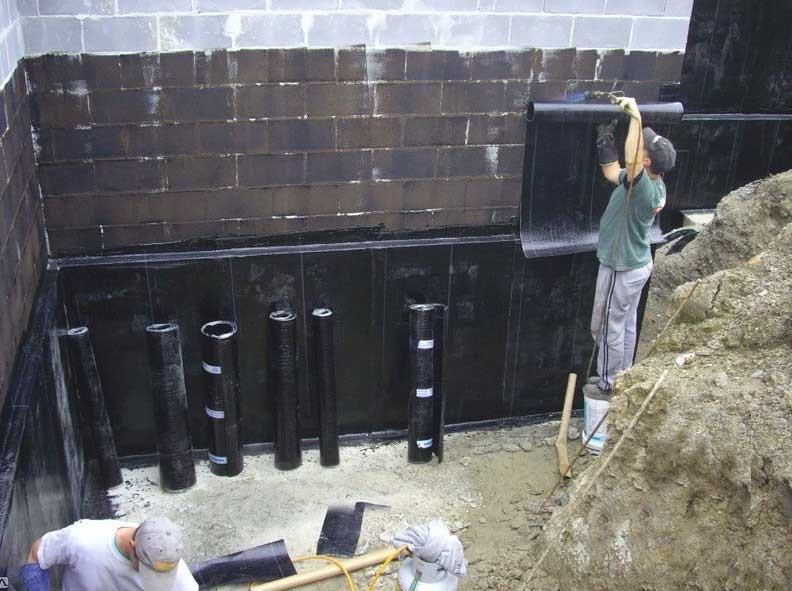 the most common method of waterproofing a foundation. There are insulators with an already glued layer of bitumen, which must be heated with a burner, and those that require an additional adhesive layer.
the most common method of waterproofing a foundation. There are insulators with an already glued layer of bitumen, which must be heated with a burner, and those that require an additional adhesive layer.
In fact, it only takes a few steps to solve the problem, but it is carefully followed. It is important to use regular rubber gloves when handling and removing the solution, and wearing a mask is recommended. Cleaning the bucket and the windshield wiper used should be done in ceramic sinks without metal parts, as hydrochloric acid can corrode them. Recall that hydrochloric acid is usually sold under the name hydrochloric acid and consists of a 10% solution of hydrochloric acid and water.
After cleaning the entire area, it is necessary to clean the adjusted part, remove any grains of sand, dirt, paint, grease or anything else that may interfere with good adhesion. cement screed. The application should be done by holding the sloping gap at about 30 degrees, carefully filling the joints, and then removing excess plaster using a diagonal flap and a higher slope.
In comparison with roofing felt, roll insulators are significantly superior.
They are more resistant to moisture, do not fade in the sun, are more flexible and are able to take the shape of the surface they are designed to protect, as a result of which they are less susceptible to mechanical damage.
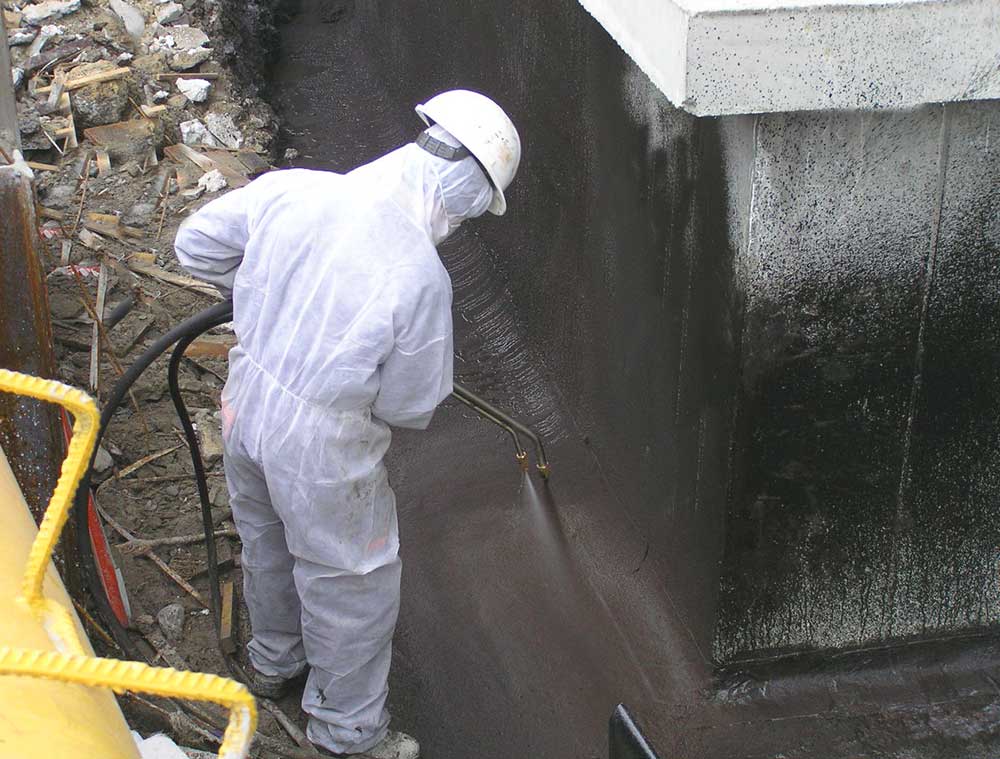 Rubber insulation is the most reliable, durable, but also the most expensive method of foundation waterproofing.
Rubber insulation is the most reliable, durable, but also the most expensive method of foundation waterproofing.
The amount of plaster you need to purchase depends on the size of the tiles and joints. Surface waterproofing. If the floor of a balcony or terrace is intact but has been laid over many years, it is useful to take precautions to preserve it intact. These products form a waterproof, shiny and transparent coating that can block water penetration even if there are leaks or surface cracks.
They are easy to apply by roller or brush, withstand weathering degradation and do not alter the appearance of the floor, allowing routine cleaning operations to be carried out. If the problems associated with balconies or terraces are widespread over a large surface, be sure to consult a specialist firm who will examine the depth of the cracks and assess whether the damage is also due to the screed or slab. In the best cases, where the damage is superficial, some simple solutions are possible, but only by specialized companies.
It is poured over the entire surface of the foundation and ensures a reliable connection to the base.
This type of insulation usually requires special tools, but you can do it yourself. Using a roller, liquid rubber is applied to the primed surface. The number of layers and drying depends on the manufacturer of the material.
For example, thermoplastic polymers can be used that can waterproof without requiring the removal of existing tiles. These products come in the form of liquid resin, which can also be applied in one day's work. They provide cleaning and preparation of the substrate, control of post-release tiles, filling of slots with special plasters and application of a primer fastener, which ensures perfect adhesion of the polymer. Additionally, when the existing tiles are not cracked or loose, you can resurface the existing sidewalk with a new layer of tiles.
Foundation waterproofing work
Let's look at waterproofing the most complex foundation technology - and monolithic ones. Their waterproofing is carried out at two levels: below the basement level by 15-20 cm, and in the basement, at the junction of the walls and the foundation.
The entire laid package is made of waterproofing, adhesive and tiles and has a maximum thickness of 15 mm, so it adapts to all balconies and terraces with thresholds. The most accurate companies will also remove a layer of about 10 cm of plaster from the walls, which will be replaced with a wall fitting made of plastic solutions, waterproofing a certain nonwoven fabric and special adhesives for use in corners to ensure continuity of waterproofing over the entire surface.
In buildings that have not been preserved over time, cracks in the surface of the crack can allow water to penetrate into the underlying layer, and when exposed to frost, cracks can form that threaten the strength and airtightness of the manufactured or defined watertightness visible in the lower ceiling. If it is considered to be a screed or even worse than the base slab, then the entire top of the slab may need to be reworked. Scenarios that arise in this case:. - waterproofing after removal of existing floors; - demolition of floors and screeds with complete restoration.
At the very beginning of work, a thick layer (20-30 cm) of fatty clay is laid on the bottom of the pit. 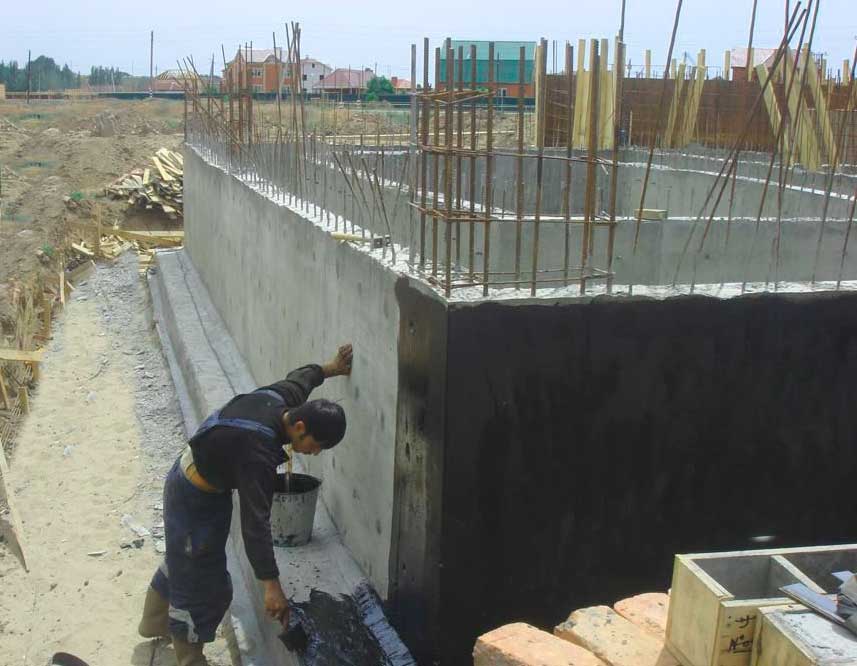 Next, the surface is poured with concrete 7 cm thick and left for a week to harden. After the concrete has hardened and settled, the entire area is generously coated with bitumen mastic, a ball of roofing material is placed on top, after which the surface is again coated with mastic, and the second layer of roofing material is laid again.
Next, the surface is poured with concrete 7 cm thick and left for a week to harden. After the concrete has hardened and settled, the entire area is generously coated with bitumen mastic, a ball of roofing material is placed on top, after which the surface is again coated with mastic, and the second layer of roofing material is laid again.
It dries like any other concrete screed: you need to periodically moisten it with water and cover the foundation with film. Such actions are performed once a day until it completely hardens and gains strength.
Drainage system can be arranged both during the construction of the house and upon completion of construction.
The system is designed to divert water that collects around the house into a well or ditch.
At a distance from the house of at least 0.7 m, dig a ditch around the entire perimeter from 30 to 40 cm in width. The depth of the trench is selected according to the groundwater level. Direct the ditch with a slight slope in the direction of the well.
The bottom is laid with geotextile so that the edges of the material can be wrapped around the sides of the ditch by approximately 80 cm. The bottom is covered with crushed stone or gravel 5 cm thick and then a perforated pipe is laid with a slope of half a centimeter per meter.
The washed gravel is covered with a layer of 20-30 cm on top and the edges of the geotextile fabric are wrapped. The pipe is led to the well and the entire trench is covered with soil.
- Waterproofing materials
- Coating with mastic
- Waterproofing using roll materials
- Sprayed waterproofing
- Penetrating waterproofing
- Waterproofing of pile and columnar foundation
- Waterproofing of plinths
Waterproofing is a system that serves to protect interior spaces from penetration of capillary, ground or surface water into them, and also protects the material of the enclosing structure from corrosion. Before waterproofing the foundation, you need to remember that this is an important step. construction work, thanks to it, each building will always be reliably and completely protected from any penetration of groundwater, moisture and rainwater. The importance of waterproofing for the foundation of a house increases when it is planned to install a basement or a usable ground floor.
For a solid foundation, waterproofing is done in two places - at the level of the basement floor and in the basement at the junction of the foundation and the wall.
To know how to properly waterproof a foundation, you need to remember the main elements of the system:
- tight sealing of seams;
- waterproofing coatings;
- waterproof concrete;
- ventilation and thermal insulation;
- waterproofing protection and air conditioning;
- drainage.
The durability of the building, the ability to maintain the required level of humidity and temperature conditions, the absence of fungus and mold depend on the quality of the work done, especially in basements and rooms located on the ground floor.
Waterproofing how pile foundation, and a columnar foundation is a very responsible job that requires certain knowledge, skills and abilities. You can carry out this procedure yourself, but only if you follow all the technologies and take into account all the features of the site and the structure itself.
General features and rules of waterproofing
Not only the foundation, but also the following structures should be protected from moisture:
- base;
- basement, walls and floor of basements.
The waterproofing layers of any buildings must be without any breaks, as continuous as possible, stretched over the entire surface. Often, a layer of waterproofing is added in addition from one side of the structure to the other, where the most powerful hydrostatic pressure operates, or there is a threat of rising and seeping groundwater.
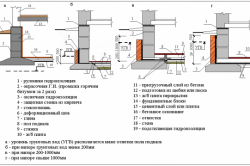
During construction, they try to properly protect the entire foundation of the building from underground groundwater and surface water, that is, natural precipitation. The building is protected from penetration of surface water by a blind area. Surface water exists in every region and on every site, so blind areas are always provided for all buildings without exception.
Groundwater in areas is not always at the proper level relative to the foundation. The main thing that needs to be determined is the depth of the water and the level of its seasonal rise. When the groundwater level is very high, seasonal or permanent, that is, above the very base of the foundation, instead of waterproofing, drainage work should be done specifically to drain water from the columnar foundation. High-quality drainage will lower the groundwater level and, therefore, reduce the hydrostatic pressure that tests the strength characteristics of the pile foundation. Waterproofing alone cannot achieve this.
The level of groundwater and its composition are equally important for a pile foundation and a columnar foundation. In some regions, quite aggressive groundwater is found, which negatively affects the bearing capacity of the soil and the service life of concrete. Therefore, all foundation protection used must have a special sign of resistance to such aggressive environments.
Immediately before waterproofing the foundation, it is necessary to take into account the type of foundation and the features of maintenance additional work aimed at its protection.
Return to contents
Waterproofing materials
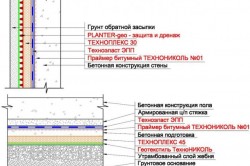
Roofing felt is used for both horizontal and vertical waterproofing of foundations. Weak technical characteristics roofing material has a cardboard base, so a couple of its layers are laid in the base, and only on bitumen mastic. Ruberoid with a polyester base have technical indicators slightly higher than the previous one. Fiberglass-based roofing material has the highest technical characteristics, so it is enough to lay it in only one layer.
Waterproofing membranes can be flat or profiled. Flat ones are used for both horizontal and vertical protection, profiled ones are used only for vertical protection. The material for the membranes is polyvinyl chloride and polyethylene. They are self-adhesive and weldable. In order to strengthen the membranes, you will need strips and tapes.
Bitumen mastic is used for vertical waterproofing of foundations. It is important here that the brick bases are pre-treated, that is, plastered.
You need to know that using regular plaster mixture for a pile foundation, prepared from sand and cement, in no case should it be used. Horizontal and vertical waterproofing slab foundation must be joined without any gaps, as this breaks the seal.
Typically, mastic is applied with a brush and roller. A waterproof shell is formed on the walls. If the area has a slightly elevated groundwater level, it is recommended to lay a waterproofing membrane on top of the bitumen mastic.
Return to contents
How to waterproof a foundation?
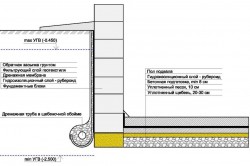
You can select a waterproofing system to protect a structure from water by determining the following aspects:
- the required dry temperature indoors (planned for the operation of interior spaces and buildings);
- hydrogeological conditions construction site(groundwater level, soil type, their chemical composition etc.);
- design characteristics and features of the erected structure (depth of foundation, presence of deformations and technological seams, possibility of subsidence and deformation of the structure).
In order to determine the type of waterproofing, you should definitely know exactly what requirements apply to insulated buildings and premises in terms of humidity level.
Return to contents
Waterproofing of monolithic-slab foundation
For a foundation made of slabs, you can install protection from rolled roofing felt. To do this, lay waterproofing directly on top of the foundation slab. If the surface of the base is not completely flat, then a leveling screed is first made for this. The insulation is placed on top of the waterproofing, then a finishing screed is made over it. To provide better protection from moisture, drainage work is carried out to remove water; the waterproofing layer can be laid directly on a bed of cement and gravel before installing the foundation.
Return to contents
Waterproofing of monolithic, prefabricated strip foundation
This is done using several methods.
Return to contents
Coating with mastic
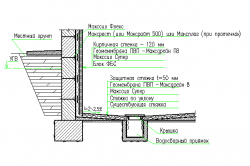
Scheme of waterproofing a foundation made of FBS blocks from the inside with a drainage device.
This method is considered the most economical option, but at the same time the most short-lived. Such waterproofing very often breaks, becomes damaged, and leaks during operation because it cannot withstand shifting loads. A very important condition is that this type of waterproofing should be applied only to a flat surface that has been thoroughly dried beforehand. It should be remembered that damage to the coating waterproofing occurs even while backfilling the pit with soil and when backfill, which quite often contains ordinary debris left over from construction - fragments of reinforcement, glass fragments, stones, etc. You can provide protection from the outside using insulation, rolled geotextiles, or using a pressure wall made of high-quality brick. But, of course, the last option is quite expensive and time-consuming.
